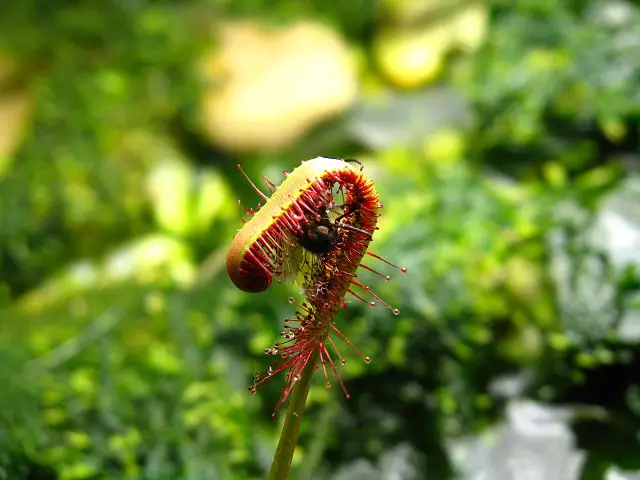Tentacles tipped with nectar cover the leaves of a sundew. Also, this nectar functions as a powerful glue, trapping any unfortunate insect that takes a sip. As an insect struggles to escape, the leaf slowly wraps itself around its trapped prey. Additionally, they signal the plant to produce digestive enzymes, which dissolve the insect. Then the liquid, nutritious soup is absorbed by the plant. Sundew leaves may curl when a non-nutritious substance falls upon them. Still, they soon reject and release the offending irritant as they know it is not of a nutritious nature. Sundews are often called “sticky flypaper traps” because they trap their prey like sticky paper.
Sundew Plant Information
Sundews come in more than 90 species. They can be found mostly in Australia and South Africa. Still, they can also grow in hot, humid climates in Georgia and Florida. These plants often grow in acidic soils and are commonly found in bogs or marshes. They are often found growing over sphagnum moss. Houseplant stores often sell sundews, which belong to the genus Drosera. It would be incomplete without describing the trap mechanism of the sundew plant. Plants have tiny, sticky filaments covered at the tips of their arms or stems. A substance secreted by these filaments helps catch and digest small prey and helps them digest their food. The arms of the insect fold in so that it can be held there for four to six days while it is digested.
How often do sundew plants eat?
Providing food for carnivorous plants is entertaining but can also be overdone. It is an energy-intensive process for the plant to capture or feed on insects; if the plant is not in peak condition, too much energy can lead to death. Sundews should only be fed one bug per time. It’s more than enough to feed them one tiny bug a week. Please wait until the first bug has been digested before feeding them another one.
How to tell if My Sundew was Overfed?
Sundews that have been overfed will be sluggish. Although it will not let go of bugs it has caught, it will not attempt to digest them. It is common for tentacles to curl and then stop partially. Although the bug is still stuck, it will not try to eat it. Instead, it will simply hold on to it. In time, the leaf or tentacle will start to blacken and eventually die.
Due to the fact that it is the undigested bug and not the empty exoskeleton, there is a risk of rot and mold since it is the bug. The plant is very likely to die as a result of this rot and mold on a long-term basis. You should remove rotting or blackened leaves and any rotting bugs whenever you see them.
In the event that you do not correct the situation, the cascade effect could lead to death for your plant. Please do not feed the plant for at least a month at this point, treating it as though it is ailing. It needs some time to recuperate and build up energy. Ensure the plant gets plenty of water and light, but wait to feed it until you see it getting more sticky dew on the tentacles.
Can you feed Sundew dead insects?
It is unnecessary for bugs to simulate being alive to trigger digestion, as it is with Venus flytraps. Dead bugs can also stimulate digestion. It is not recommended to buy live insects merely to feed your Sundew. The insects will be excessively numerous, and you’ll be feeding them so rarely that most of them will die. The sundews will eat anything they can catch and will not be able to get away from them. Basically, if it sticks to Sundew, Sundew will try to eat it. Generally, you don’t need to worry too much about whether the insect is dead or alive.
Do I need to feed my sundew plant?
You can feed various insects and other types of food when you keep your Sundew indoors. You can find gnats, spiders, ants, fruit flies, moths, and houseflies. Try dehydrated insects, like melee worms or fly larvae, if you cannot catch any insects. It is best to moisten the dried insects before feeding them to your sundews, and do not give them insects that are difficult to eat, like grasshoppers or beetles. You should only feed them once every two weeks, once a week at the most. So don’t overfeed them.

Conclusion
Known as “flypaper” plants, Sundew leaves trap prey in sticky hairs. Plants in this family make up the largest group of carnivorous plants. These plants have long tentacles protruding from their leaves, each of which has a sticky gland. Their name comes from the fact that they look like dew droplets glistening in the sun. As well as producing nectar, the glands produce an adhesive to trap prey as well as enzymes for digesting it. Insects become smothered after becoming stuck when nearby tentacles coil around them. Some of the species are tall and have a vine-like appearance, while others cling to the ground, so their size varies. In some cases, Sundews can reach a height of more than 10 inches (25 centimeters).
Mosquitoes can comprise a significant part of the sundews’ diet in their preferred habitat since they are abundant there. Their main food source is insects. Insects trapped in sundews can be killed in 15 minutes but may be digested over a few weeks.

